The Samsung 840 EVO is an mSATA SSD that is the first to hit the 1TB capacity point. Though it has a compact mSATA form factor, roughly a quarter of the size of a standard 2.5” SSD, it packs the performance punch of its larger siblings. Ultra-thin laptops have been limited in their storage capacity up until now. Taking advantage of Samsung’s advances in flash memory, the 840 EVO mSATA SSD will take portable computing capacity and speeds in ultra-thin computers that was previously unattainable. To get to the 1TB capacity point, Samsung uses a total of four flash memory packages, each having 16 dense layers of 128Gb TLC chips.
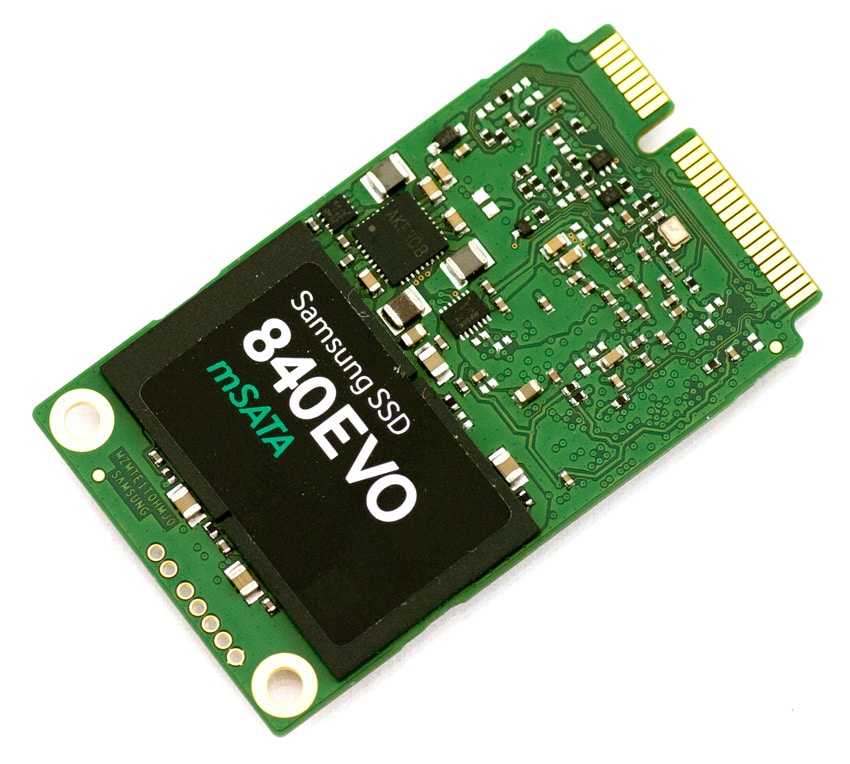
Another area where the 840 EVO mSATA SSD excels is security. Not only is the device self encrypting, like most SSDs, it also allows class 0 and eDrive to be enabled easily. The 840 EVO mSATA SSD is complaint with TCG Opal and IEEE 1667 standards. The drive is also compatible with the Samsung Magician drive management software suite, which is the most robust offering in the market. Lastly, it's worth noting that all core components come from Samsung themselves, including the drive controller, NAND and DRAM. This level of integration gives Samsung several advantages from drive design and support to pricing power in retail.
The Samsung 840 EVO mSATA SSD is available in 120GB, 250GB, 500GB and 1TB capacities and has a street price ranging from $150 to $860.
Samsung 840 EVO mSATA SSD Specifications:
- Max capacity: 1TB
- Memory: 1GB LPDDDR2 DRAM
- Controller: Samsung MEX (3x ARM Cortex R4 cores @400MHz)
- NAND: 19nm Samsung TLC
- Interface: SATA
- Form Factor: mSATA
- Power Consumption
- Start-up: 2.01W
- Idle: 0.44W
- Dimensions Height x length x Thickness: 3cm x 5cm x 3.85mm
- Weight: 8.5 grams
- Warranty: 3 year limited
Design and Build:
The Samsung 840 EVO mSATA SSD is about 40 percent smaller and 12 times lighter than the standard HDD or in other words about 1/3 the size of a standard business card.
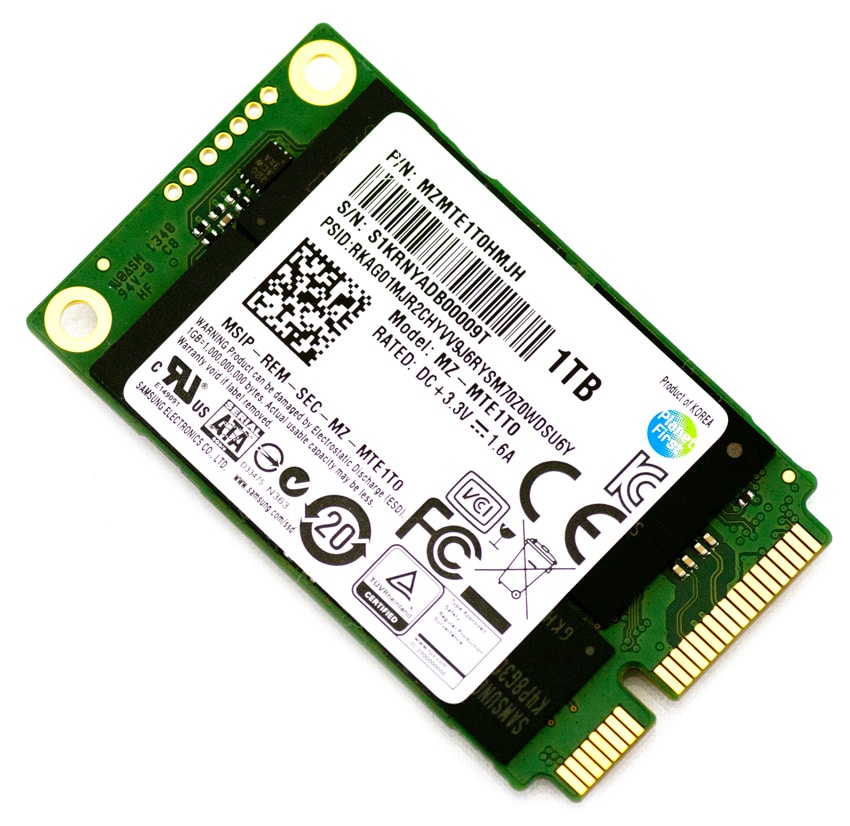
On the device itself is a large sticker that covers the components. Under the sticker hides the Samsung controller, DRAM cache, and two NAND packages.
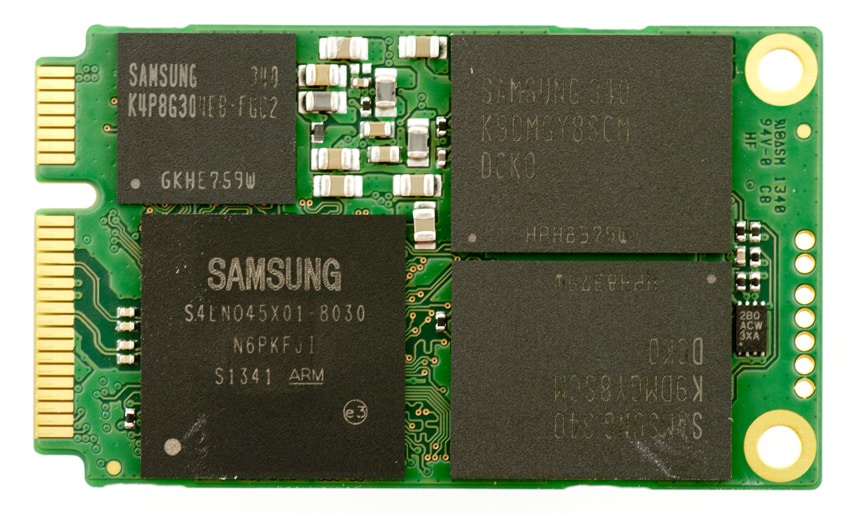
Flipping the device over reveals the other two NAND packages. All in all, squeezing 1TB of storage into this miniscule form factor is impressive engineering.
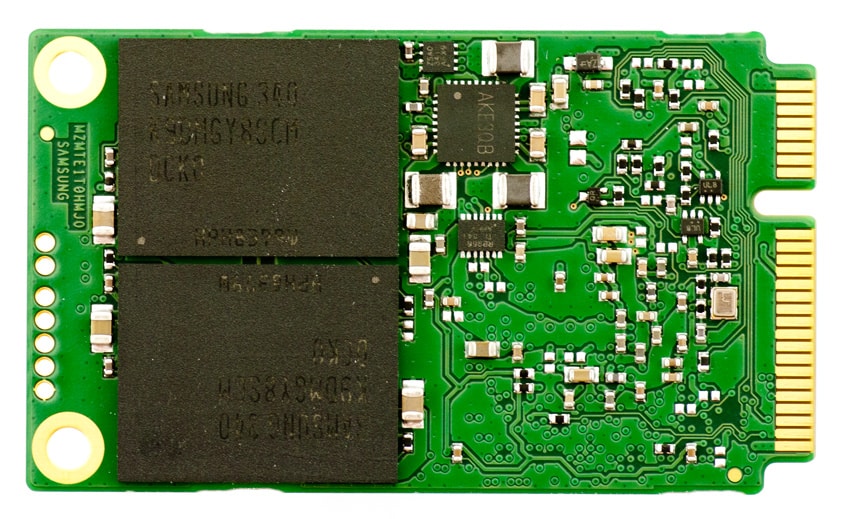
Performance:
All consumer SSD benchmarks are conducted with the StorageReview Consumer Testing Platform. The comparables used for this review include:
- Intel 310 mSATA 80GB SSD
- OCZ Nocti mSATA 120GB SSD Repeating
- OCZ Nocti mSATA 120GB SSD Random
- Micron RealSSD C400 mSATA 128GB
- Plextor M5M mSATA 256GB
- Intel SSD 525 Repeating
- Intel SSD 525 Random
In our first benchmark we tested straight-line sequential performance using a 2MB transfer size. 840 EVO inched out the others to have a top read activity of 509 and a top write activity of 469 just ahead of the Intel 525 Repeating.
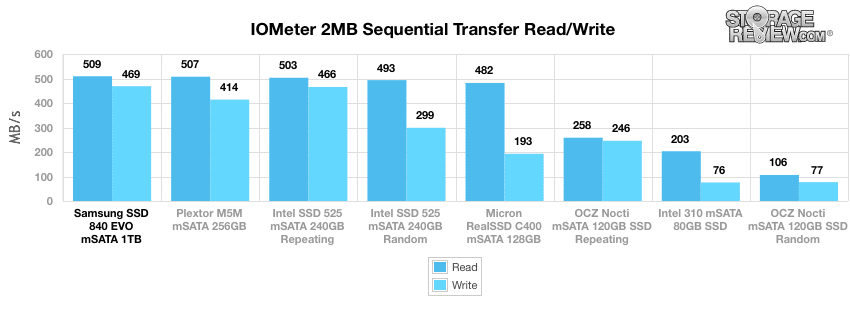
Our next test maintains the 2MB transfer size, but this time we are measuring random transfer speeds. This time the 840 EVO came in second to the Intel 525MB/s Repeating with read activity (measuring at 499MB/s and 504MB/s respectively) but came out on top with write activity with 484MB/s.
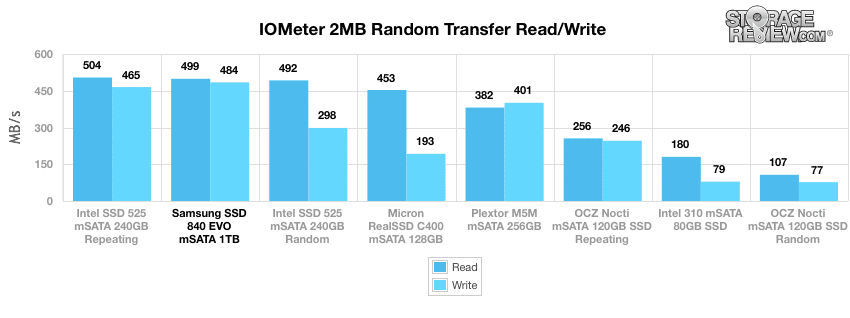
In our next test, we measure low queue depth random 4k read and write performance. Here, the 840 EVO came out on top with a little higher lead with 38.38MB/s read and 77.26MB/s write activity.
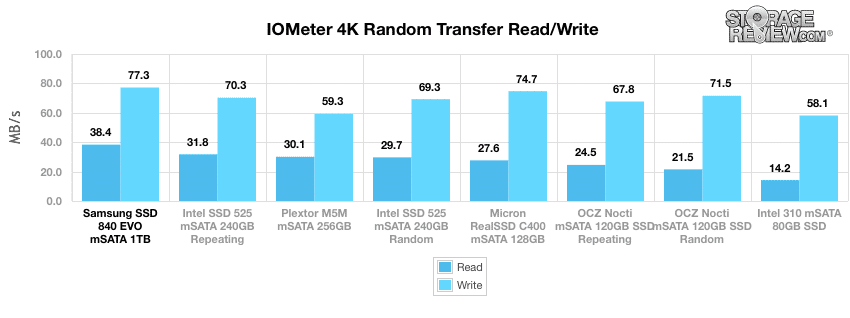
Next we measured random 4K throughput. The 840 EVO had quite the lead with read activity coming in with 9,826 IOPS (the next highest being the Intel 525 Repeating at 8143 IOPS). The 840 EVO was higher than the others with write activity as well at 19,780 IOPS.
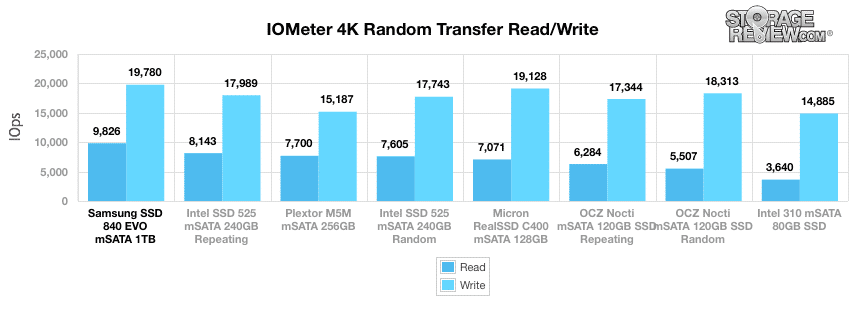
Expanding our 4k test, we look at write latency of each SSD. Max latency is also important, although that number can change as the NAND experiences wear over time. We measured an average latency of 0.0500ms from the 840 EVO, which was the best of the group tested. However it’s max latency came in second at 5.914ms.
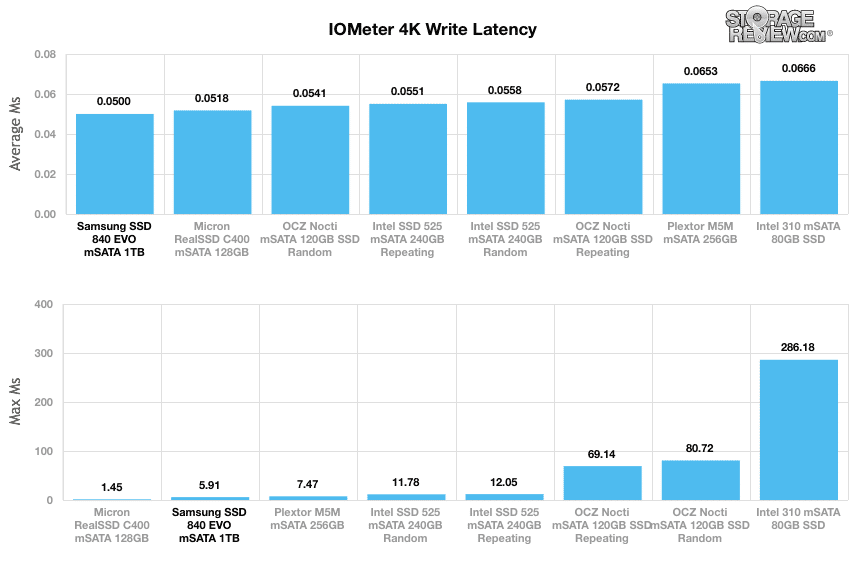
In our next test, we shift to a smaller 4k random workload with 100% read activity that scales from 1QD to 64QD. In this setting, the 840 EVO scaled from 9,958 IOPS up to 99,024 IOPS maintaining the top spot throughout the test.
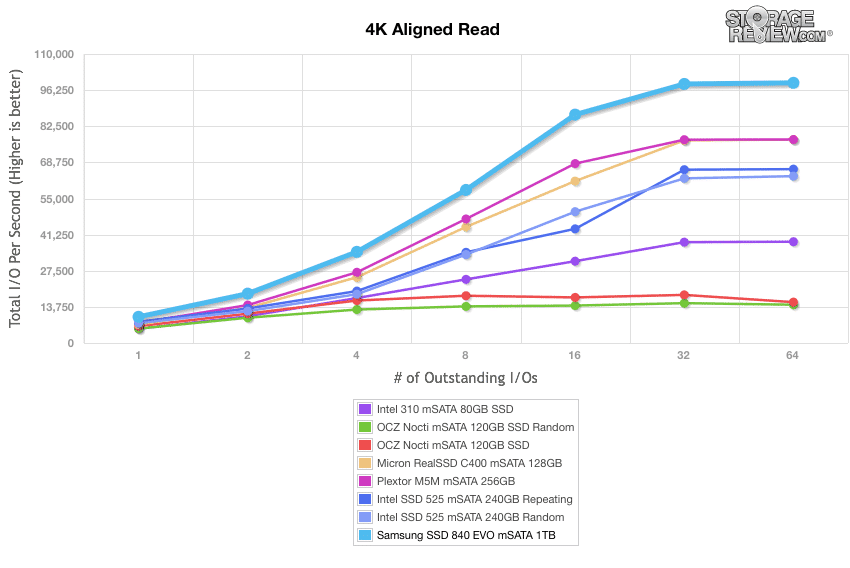
Shifting focus to write activity, the 840 EVO started out high but dropped slightly behind the Intel 525 (both repeating and random) and then pulled ahead in higher queue depths. The 840 EVO scaled from 20,156 IOPS and peaked at 90,072 IOPS before dropping down to 89,589 IOPS.
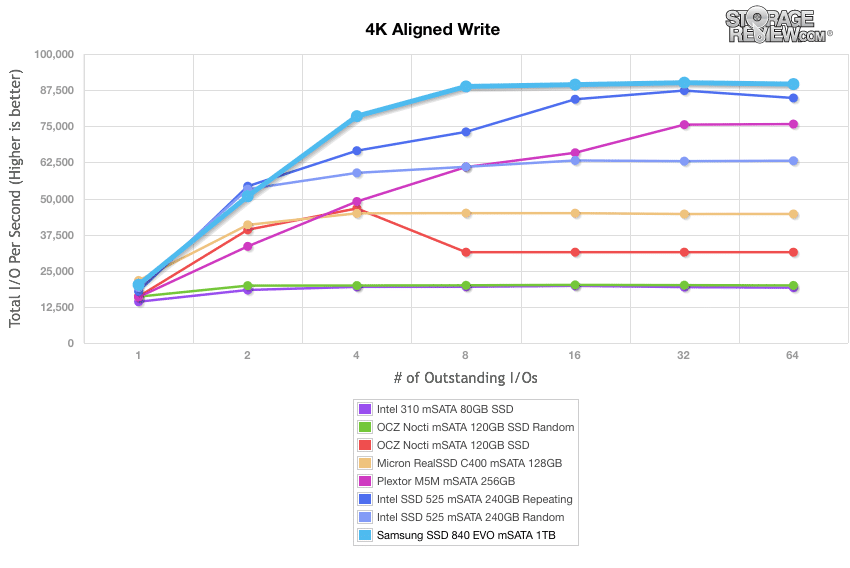
Our last series of synthetic benchmarks compare the hard drives in a series of server mixed-workloads with a queue depth of ranging from 1 to 128. Each of our server profile tests has a strong preference towards read activity, ranging from 67% read with our database profile to 100% read in our web server profile. In all of our mixed workloads, the Samsung 840 EVO ranked near the top of the pack running close with the Intel 525 Repeating.
The first is our database profile; with a 67% read and 33% write workload mix primarily centered on 8K transfer sizes. In the test, the 840 EVO was trading the top performer with the Intel 525 Repeating. Both peaked at Q64 with 45,277 IOPS and 45,286 IOPS respectively.
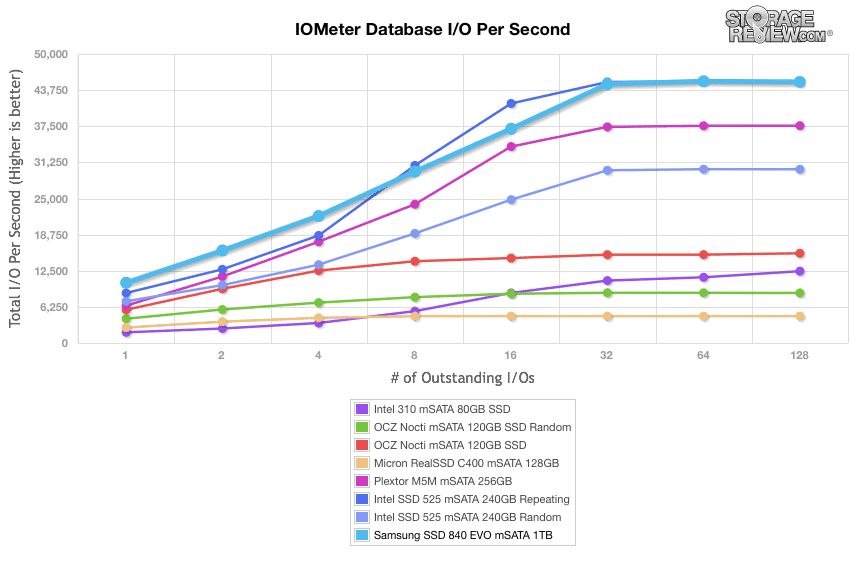
Our web server profile is read-only with a spread of transfer sizes from 512-byte to 512KB. The 830 EVO out performed all other drives from beginning to end.
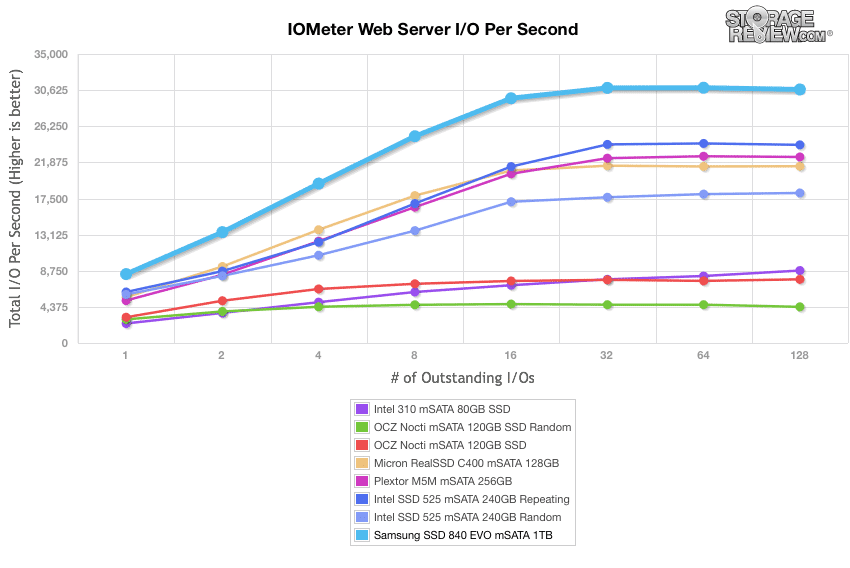
The next profile looks at a file server, with 80% read and 20% write workload spread out over multiple transfer sizes ranging from 512-byte to 64KB. The 840 EVO started off high but again began to trade the top spot with the Intel 525 Repeating. However it does finish on top peaking at 35,257 IOPS.
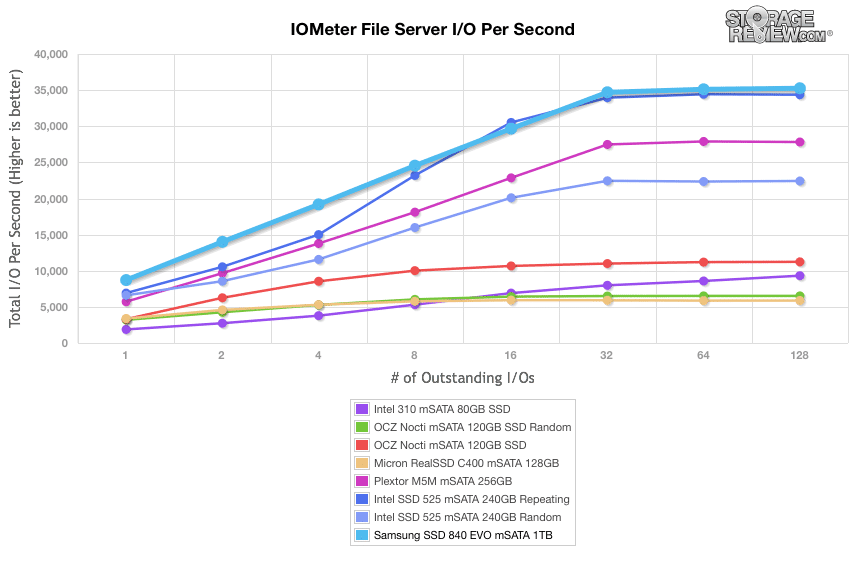
The last profile looks at workstation activity, with a 20% write and 80% read mixture using 8K transfers. The 840 EVO started strong and was able to maintain its lead throughout.
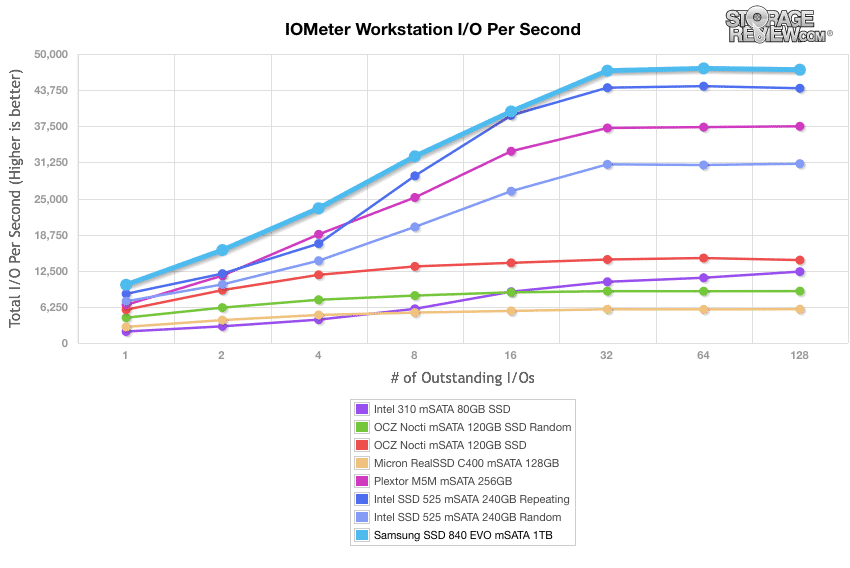
Consumer Real-World Benchmarks
For the average consumer, trying to translate random 4K write speeds into an everyday situation is pretty difficult. It helps when comparing drives in every setting possible, but it doesn't exactly work out into faster everyday usage or better game loading times. For this reason we turned to our StorageMark 2010 traces, which include HTPC, Productivity, and Gaming traces to help readers find out how a drive might rank under these conditions.
The first real-life test is our HTPC scenario. In this test we include: playing one 720P HD movie in Media Player Classic, one 480P SD movie playing in VLC, three movies downloading simultaneously through iTunes, and one 1080i HDTV stream being recorded through Windows Media Center over a 15 minute period. Higher IOps and MB/s rates with lower latency times are preferred. In this trace we recorded 2,986MB being written to the drive and 1,924MB being read.
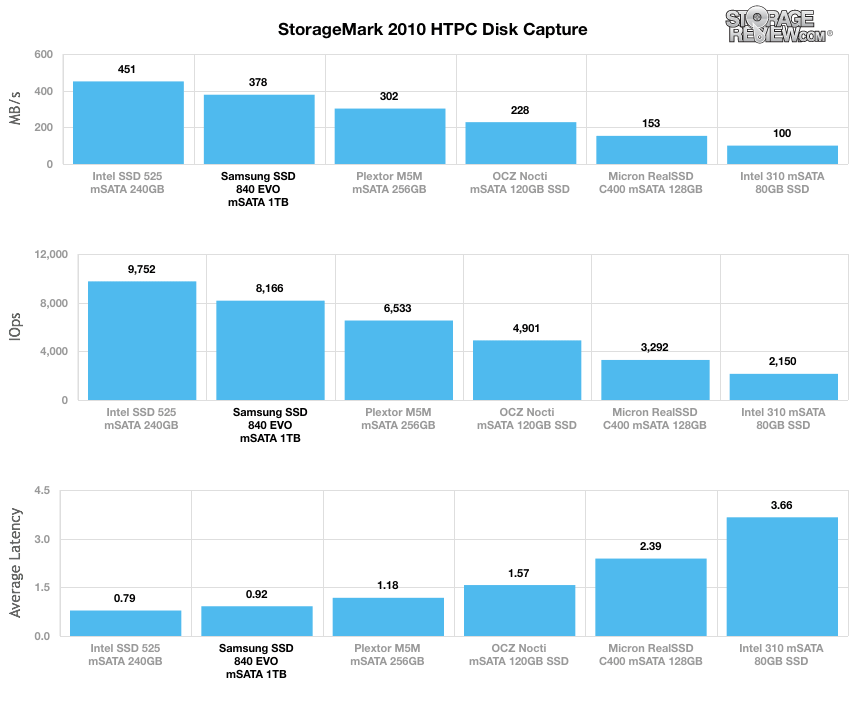
The 840 EVO came in second with each test being beat out only by the Intel 525.
Our second real-life test covers disk activity in a productivity scenario. For all intents and purposes this test shows drive performance under normal daily activity for most users. This test includes: a three hour period operating in an office productivity environment with 32-bit Vista running Outlook 2007 connected to an Exchange server, web browsing using Chrome and IE8, editing files within Office 2007, viewing PDFs in Adobe Reader, and an hour of local music playback with two hours of additional online music via Pandora. In this trace we recorded 4,830MB being written to the drive and 2,758MB being read.
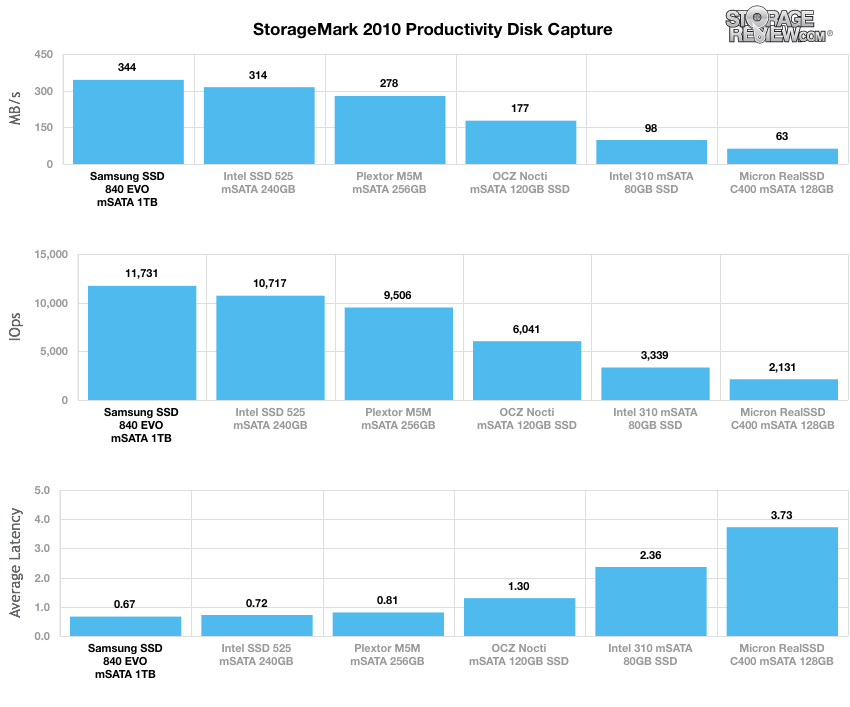
This time the 840 EVO came out on top, registering 11,731 IOPS, a speed of 344.22 MB/s, and an average latency of 0.665, beating the Intel 525 that came in right behind it on each test with 10,717 IOPS, 344.29 MB/s and an average latency of .718.
Our third real-life test covers disk activity in a gaming environment. Unlike the HTPC or Productivity trace, this one relies heavily on the read performance of a drive. To give a simple breakdown of read/write percentages, the HTPC test is 64% write, 36% read, the Productivity test is 59% write and 41% read, while the gaming trace is 6% write and 94% read. The test consists of a Windows 7 Ultimate 64-bit system pre-configured with Steam, with Grand Theft Auto 4, Left 4 Dead 2, and Mass Effect 2 already downloaded and installed. The trace captures the heavy read activity of each game loading from the start, as well as textures as the game progresses. In this trace we recorded 426MB being written to the drive and 7,235MB being read.
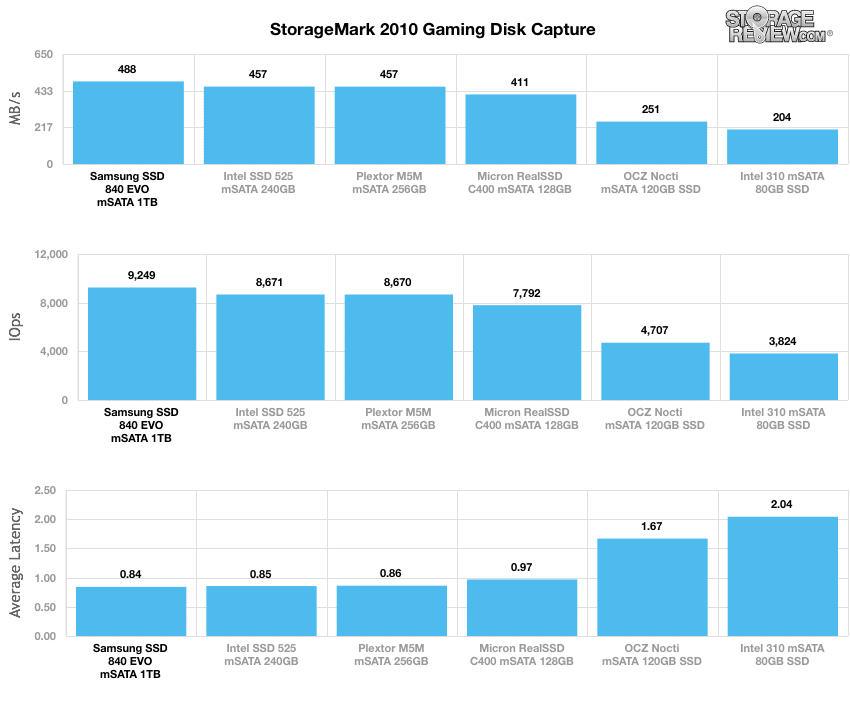
The 840 EVO again came out on top in throughput and latency, just beating the Intel 525.
Power Consumption
As SSDs spend much of their time in the idle state, low idle power consumption is a key factor in overall SSD power management.

In our tests, we measured great idle power consumption from the Samsung 840 EVO at 0.44W. During write activity it scored 3.69W. Its read and random read scores were 4.32W and 2.31W respectively. And it had a start up consumption of 2.01W.
Conclusion
The Samsung 840 EVO mSATA SSD is the first 1TB mSATA SSD to hit the market. It packs a powerful punch in performance and capacity for such a small form factor. Not only does it carry a lot of capacity through its unique design it also has strong security features to keep your data secure and leverages the Magician software package for drive management. For ultra-thin form factors, the EVO mSATA provides much-needed headroom for those needing larger in-system capacity options without giving up performance needs.
From a performance perspective, the Samsung 840 EVO is highlighted by its strong showing in our real-world workloads, ranking second in our HTPC trace. In Productivity and Gaming traces it came out on top of the pack in both instances showing excellent throughput and latency. Measuring single workloads, the 840 EVO was either the top or the second performer in 2MB sequential read speeds and remained that way in 4K random write speeds. Looking at mixed workload performance in our server profiles, the 840 EVO again out performed the other drives being tested. Overall, the Samsung 840 EVO proved itself to be a strong competitor in all of our consumer-focused workloads compared to other top-performing consumer SSDs along with much more capacity than the others.
Pros
- Up to 1TB capacity
- Core components all made in-house
- Low power consumption
Cons
- TLC NAND might concern some buyers
Bottom Line
The Samsung 840 EVO mSATA SSD 1TB delivers class-leading performance and capacity to those wanting the absolute best of both worlds for their ultraportable device.
Samsung 840 EVO mSATA at Amazon



 Amazon
Amazon